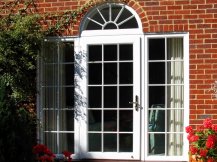There are several different types of windows. Traditionally, most windows were side-hinged windows, referred to as casements, and sliding sash windows. New opening mechanisms such as friction and pivot hinges are increasingly popular. Window materials, shapes, and sizes vary considerably, as does terminology, so you should read your manufacturer's literature carefully. Replacement windows for older homes often need to be custom-built to your requirements.
Choosing Windows
Commonly, the material and mechanism of a replacement window is chosen to match the originals. There are some exceptions-new sash windows, for example, will often be equipped with modern spiral balances, although they look the same as original lead counterweight versions. If you are replacing all the windows in your property, or building a new home, then take time to consider energy-efficient products such as double and even triple glazing. Frames may have a sill attached, an optional sill, or none at all. If your old frame has a sill attached, make sure your replacement has one.
Window Materials
Most styles of windows are available in a number of different materials. Each material has advantages and disadvantages in terms of maintenance and appearance.
2007 Dorling Kindersley Limited
Wood
Windows were traditionally made of wood, and it is still popular because it is so versatile. If old windows are drafty, you can install weather stripping. Hardwood is expensive, but is durable and only needs the protection of oil. You can also paint hardwood windows or give them a natural finish. Softwood windows need to be protected by paint or a natural wood finish, and regularly maintained.
Vinyl
Double-glazed, vinyl windows offer excellent heat and sound insulation. Old windows are often replaced throughout a house by new vinyl windows. In addition to white, other finishes are available, such as wood-grain. Vinyl requires little maintenance.
Aluminum
Where maximum light is required, aluminum windows can be an excellent option-the strength of aluminum means a thin frame can support a large expanse of glass. However, aluminum conducts heat out of the home and is prone to condensation. Double-glazing may be required by building regulations to reduce heat loss. Old aluminum windows were prone to rust, but modern versions are coated during manufacturing and are durable and low-maintenance.
Other Materials
Windows can be made from a combination of materials. Aluminum windows, for example, often have a wooden core, and steel casements can be housed in wooden frames to reduce heat loss. Frames with decorative real wood on the inside, and maintenance-free fiberglass or vinyl exteriors are also available. Traditional lead lights are made up of small pieces of glass held between strips of lead within a wood frame. Other types of windows are available with lead-light-effect double-glazing.
As well as metal casement windows, vinyl casements, seen here, and wood casements are also common.
Parts of a Casement Window
Casement windows are widely used. Many of the terms used to describe the parts that make up a casement window also apply to other windows.The window is made up of one or more opening casements, hinged along one side. Top-hung and side-hung casements are available.
Wooden Casement Window
In this example, a glazing bar divides glass in the same casement.
A distinctive, traditional design with two vertically sliding sashes. Modern sashes are made of wood or vinyl, and some versions allow tilting of sashes for easy cleaning. In this example, the top sash slides down, and the bottom sash slides up.
Building Regulations
Check with the local building code department before replacing any windows. New windows may be subject to energy regulations or emergency escape and rescue requirements.
If you are working on a historic building, you must check with the local building department and/or the historical preservation board before replacing any windows.
Custom Casement Screened WindowCustom windows offer you a selection of sizes and styles that can meet any needs. When you order custom windows, you have options to include special glass, lites, or other features like this window screen.
In this custom window, the side swings out, and the screen fabric rolls down.
Grilles and Divided Lites
Windows divided with smaller panes were historically easier and much more affordable to produce than large sheets of clear glass. Today, even though technology allows us to create larger panes of glass that are much less expensive, the traditional look has become very popular. The smaller panes of glass in a window are called divided lites. They are separated by strips of wood called grilles. True divided lite windows are manufactured in the traditional method with a solid wood frame broken into shapes with wood strips.
Historic Style
Grilles are a popular choice on newer homes' windows. Adding a touch of historic style, grilles are offered in the same material as your window frame. Some manufacturers offer removable grilles.
Removing or Adding Grilles
If you would like the look of a divided lite window, but are not concerned about having true divided lites, manufacturers offer detachable grilles. These provide the same look as the true divided windows, but are available at a lower cost. With detachable grilles you also have the option of removing them and cleaning behind the grilles when necessary.
Butt hinges are used along the top edge of older designs; newer awning windows use friction hinges at either end of the top edge. Both arrangements allow the bottom edge of the window to swing open.













